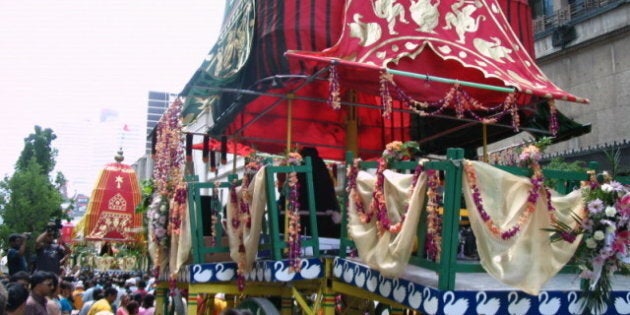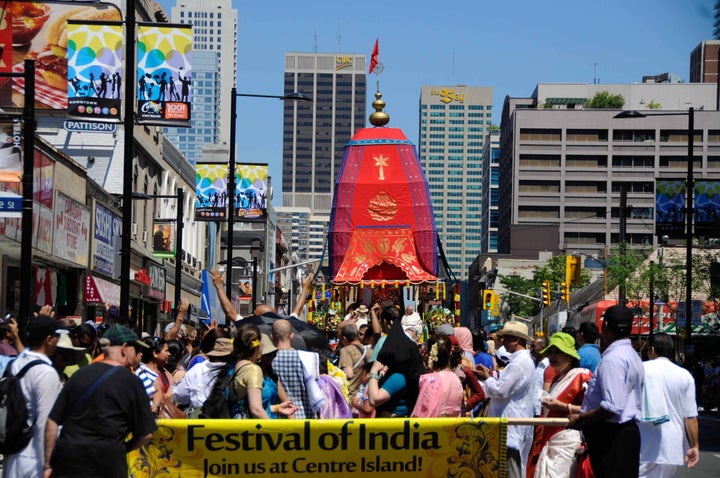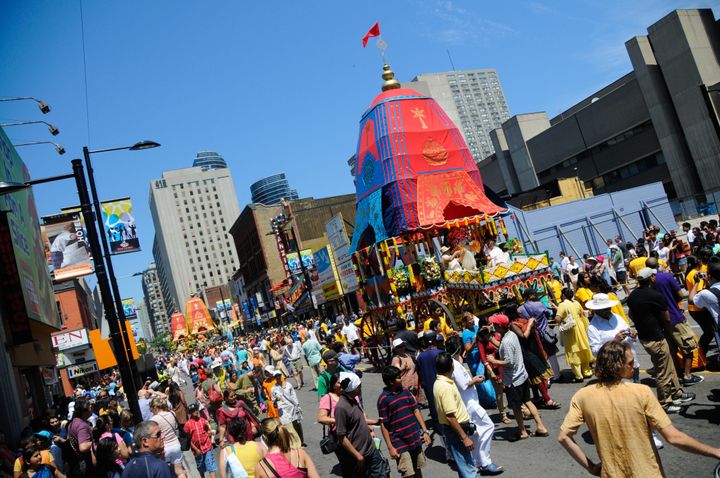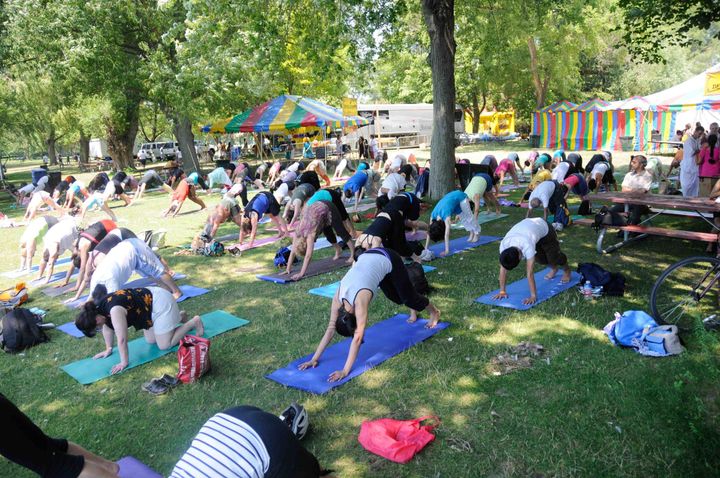
The arrival of the Toronto International Film Festival neatly heralds the end of the summer festival season in the city and Canada as a whole. However glamorous the parade of celebrities on the red carpet may seem, nothing quite compares to the peculiar sight of the Ratha Yatra in Toronto and across the country. Mimicking the original Indian procession in the city of Puri, several devotional floats dedicated to the Hindu God Krishna, also known as Lord Jagannath, roll down the street, accompanied by exuberant crowds extolling a familiar chant:
Hare Krishna Hare Krishna
Krishna Krishna Hare Hare
Hare Rama Hare Rama
Rama Rama Hare Hare

Credit: Rishi Kumar
More than four decades after appearing everywhere in popular culture from Dawn of the Dead and Airplane! to The Simpsons and the Grand Theft Auto video games, the followers of ISKCON, the International Society for Krishna Consciousness, known more affectionately as Hare Krishnas, are not only alive, they're doing surprisingly well as a colourful procession down the city's Yonge Street demonstrated. Traversing over to Centre Island, as many as 40,000 people took part in lectures, yoga exercises, vegetarian feasts and kirtans (musical chanting) over a July weekend. Rinse and repeat in Montreal, Thunder Bay, Vancouver, Calgary and Edmonton and you know what the "Festival of India" is all about.

Credit: Rishi Kumar
Juxtaposed against the bustle of industry delegations, diaspora conferences and of course the glitz and glamour of June's International Indian Film Academy Awards as well as long-running local celebrations such as the Mosaic Festival and Masala! Mehndi! Masti!, this event didn't garner the same headlines in Toronto. Ironically the Festival of India handily predates all of the above -- exposing North Americans to contemporary Hinduism since 1979.
In actuality, the Festival of India is a bit of a misnomer as it is organized and managed around propagating the teachings of a single man: A.C. Bhaktivedanta, also known as Srila Prabhupada. Bhaktivedanta introduced the Hare Krishnas to the Western World starting in New York City in 1965. The credit for introducing Hinduism to North America dates further back, perhaps to Swami Vivekananda and his 1893 address to the Parliament of World Religions in Chicago, or even to Indophilic 19th Century writers such as Henry David Thoreau and Ralph Waldo Emerson. Whereas other Indian festivals maintain a decidedly secular air (such as the "Festival of South Asia," which occurred on exactly the same weekend on Toronto's Gerard Street), this one is not only a Hindu festival but specifically a Vaishnavist one -- worshiping the god Krishna. And by criss-crossing North America in a long bright yellow rig, its devote acolytes certainly win points for presentation as well as longevity. Even the roadies talk in terms of "personal validation" and "spiritual evolutions."

Credit: Sam Singh
Bhaktivedanta came to the West on a mission to spread his message, according to Graham Dwyer and Richard Cole, authors of The Hare Krishna Movement: Forty Years of Chant and Change. Despite his advanced age and humble start alone in a Brooklyn flophouse, Bhaktivedanta got busy. By 1969 he had established ISKCON centres in New York City, San Francisco, Montreal and London. Emerging around the same time as Maharishi Mahesh Yogi (a spiritual celebrity in his own right who pioneered transcendental meditation and "yogic flying"), Bhaktivedanta rode a wave of Western fascination with Eastern thought. He quickly became one of the central figures in the "Flower Power" era of the 1960s, befriending cultural icons like beatnik poet Allen Ginsburg and the Beatles' George Harrison, who would personally fund the movement in the UK in the 1970s. Bhativedanta was staggeringly successful in spreading his message, particularly to non-Indians: by the time of his death in 1977, he had spread ISKCON to 108 temples on six continents.

Credit: Rishi Kumar
His teachings revolved around Vedic Scriptures, the oldest texts in Hinduism and the parables of Krishna as recounted in tomes like the Bhagavad Gita (The Song of the Lord), which details the climax of the Mahabharata epic when the warrior Arjuna questions Krishna on the meaning of duty and action on the eve of great battle. Starting with his original translations, Bhaktivedanta's followers strove to make his teachings widely accessible in multiple languages.
However the chairperson of Toronto's Festival, Krishna Sharma, is careful to draw a distinction between being a Hare Krishna and a Hindu. He says the Hare Krishna movement (also known as "Gaudiya-Vaisnavism") is "a spiritual science, not a dogmatic faith. It's about seeing spirituality in everyone and everything and having a relationship with the divine -- be it Krishna, Jehova, Allah, Buddha or Yaweh; however you choose to perceive it."

Credit: Rishi Kumar
Sharma, who's father met Bhaktivedanta in 1976, says the movement appeals to those looking for spiritual growth. The "shaven-headed robed guys in the airports or on the streets with their drums handing out leaflets... who may have been innocently overzealous in their devotion" have matured from the faddish fascination of the '60s to the point that the "guy sitting in the cubicle next to you" could be a Hare Krishna. Like other followings, the Hare Krishna movement splintered after the death of its charismatic leader but seems to have recovered from the accusations of cultism and misconduct that dogged some of its chapters in the 1980s.
One constant about the movement is the almost rapturous chanting that accompanies an otherwise austere lifestyle, a practice that attracts both curiosity and derision. Comparing it to a piece of Swiss chocolate, Sharma says, "When you're with someone you care about and you share with them something that you have you almost get more pleasure out if it than you got before. This is the essence of the Hare Krishna culture. It comes down to wanting to share that great piece of candy. If you're not doing that its almost like 'why be so selfish'?"

Credit: Rishi Kumar
Indeed if there's any question about Hare Krishnas that could elicit a sigh of exasperation from Sharma its the connection to yoga, which he calls a "double edged sword." Though Bhakti Yoga ("the yoga of devotion, of the heart, of love") was on display at the festival as part of the "Yoga Meltdown," Sharma is frustrated with discipline's dilution and commercialization, citing for example a Hindu movement in the United States that wants to "take back" yoga:
"If I could snap my fingers and have everyone connect mainstream yoga practices... with the original spiritual practices of yoga, I would. What I hope others see is that like the Hare Krishna practice itself, it is a movement from the physical side to the spiritual side to the Mantra side... you're only at the tip of the iceberg when you're just at the physical side of the yoga."
The Festival of India continues through the United States in September and October, before ending the year in New Orleans in mid-November.